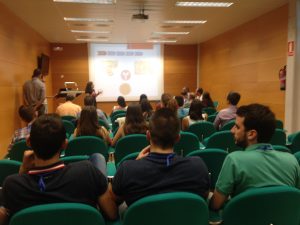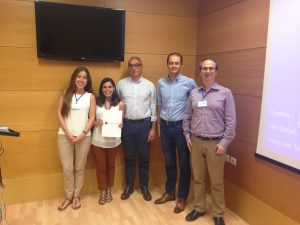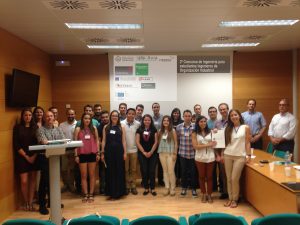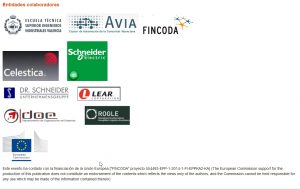Visitas: 15
Categoría: ROGLE
para entrar en el agregador de www.rogle.info
Apertura de la 7ª edicion del MOOC sobre grupos de mejora de procesos en EDX.org
Visitas: 20
Mis aplicaciones favoritas. Paneles para interacción en grupo y KPIs individuales
Ayer descubrí tres aplicaciones «nuevas» para mi. En el fondo están relacionadas pues se pueden usar para gestionar tareas, aunque tienen dos enfoques totalmente distintos.
La primera de ella es PADLET (https://es.padlet.com/). Realmente es un «muro» que puedes compartir con un conjunto de personas para que interactúen sobre en el formato «post-it» (diferente de la cronología lineal de muros tipo facebook, instagram o twitter). Mi opinión es que no es diferente de Trello (https://trello.com/) o de Lino (http://en.linoit.com/) y, personalmente, lo veo mucho más limitado. Creo que trello es más potente y está mejor trabajado como herramienta para gestión de tareas en grupo y Lino es mucho más «visual» e interactivo. Realmente lino trabaja con toda la pantalla como si fuese un «corcho» donde pegar las cosas donde quieras (cualquiera del grupo puede mover las etiquetas a cualquier lugar). De momento Lino sigue siendo la herramienta más parecida a un post-it virtual que conozco. Trello (y Padlet) tienen otras funcionalidades (que las hacen muy interesantes) pero parecen restringidas a trabajar por columnas. Puedes desplazar las notas dentro de la columna,c rear columnas o mover notas a otras columnas, pero no tienes libertad de desplazamiento dos dimensiones como en Lino.
El segundo enfoque es el de GoalMeter (https://play.google.com/store/apps/details?id=com.goalmeterapp.www&hl=es) y HabitBull (http://www.habitbull.com/). Estas aplicaciones solo están disponibles en Android/IOs, no se pueden trabajar desde web. Ambas son una especie de panel de control (dashboard) de resultados (KPIs) individuales para evitar la procastinación. De alguna forma se relacionan con «Getting Things Done» y articulan las metas sobre tareas y agendas. Pero su enfoque principal es en el seguimiento de metas y el efecto motivador que puede producir el ver que las consigues o el «pique» personal por intentar lograr tus metas. Ambas tienen un entorno virtual atractivo (mucho más para GoalMeter) y recompensas gamificadas para mantener la motivación en el logro de las metas.
La base científica de ambos es el uso de KPIs e información visual de la evolución de los mismos («dashboards») como potenciadores de la motivación para mejorar la eficacia y la eficiencia. No he realizado una revisión sistemática que me permita valorar la evidencia de que existe una relación causa-efecto entre estas herramientas y un mayor logro de resultados individuales o del grupo. Sin embargo, lo que puedo apuntar es que parece que hay material escrito como para plantearse ese reto:
- en google Scholar 2.500 referencias entre 2000 y 2017 https://scholar.google.es/scholar?as_q=motivation+kpi+dashboard&as_epq=&as_oq=&as_eq=&as_occt=any&as_sauthors=&as_publication=&as_ylo=2000&as_yhi=2018&hl=es&as_sdt=0%2C5
- En Scopus no hay tanto material (quizás haya que refinar la estrategia de busqueda): 69 resultados con TITLE-ABS-KEY ( motivation AND ( kpi OR «key performance indicator» ) ) AND PUBYEAR > 1999; y 13 con TITLE-ABS-KEY ( motivation AND performance AND dashboard ) AND PUBYEAR > 1999
Entradas relacionadas:
Mis aplicaciones favoritas. Trackers y gestores de tareas
Visitas: 96
¿El imperio de los nómadas laborales o la necesidad de supervivencia extrema?
Hoy me han compartido un enlace que considero interesante. En él se plantea (o intuye) un sistema de relaciones laborales que ya he leído en otros artículos o he escuchado en conferencias de directivos de recursos humanos donde le ponen otros nombres o enfoques, pero creo que apuntan a lo mismo. El artículo lo puedes leer en
http://www.expansion.com/emprendedores-empleo/empleo/2017/10/19/59e8b768ca47415c118b45b7.html
Yo sospecho que, artículos como este, son la forma en que determinado lobby empresarial (formal o informal) está intentado presionar a los legisladores para que acaben con todo resquicio de garantías de «estado de bienestar» vendiéndolo como es algo deseado por los trabajadores «nomadas», cuando en el fondo lo que se busca es evitar cualquier compromiso con la fuerza laboral (al tiempo que se espera o exige de los «colaboradores» un 150% de compromiso con la organización).
No critico que se busque más flexibilización desde las empresas, pero reconozco que puede haber muchos más aspectos negativos de los imaginados detrás del desmantelamiento total de los derechos de los trabajadores, porque la gente no es tonta y la asimetría de «poder» se acaba pagando (y toda la historia de conflictos laborales del XIX y las primeras dos terceras partes del XX son una prueba de ello).
Insisto en que no es una cosa sencilla y comprendo las preocupaciones desde el lado de la gerencia cuando tienen las manos y las decisiones muy atadas por la ley y la balanza se desequilibra hacia el otro lado… toda situación de excesiva ventaja acaba derivando en abusos (implícitos o explícitos).
Sin embargo, haciendo una analogía histórica, los humanos empezamos siendo nómadas por necesidad (no porque nos gustara). Porque en el momento que conseguimos la mínima posibilidad de ser sedentarios, la adoptamos y entonces empezó a crecer la civilización, gracias a unas condiciones que permitían el máximo desarrollo del talento humano (a costa de excluir a otras especies y fagocitando recursos). Supongo que, del mismo modo, estos «nómadas» lo son porque no les queda otro remedio (alguno lo será por vocación, igual que quedan aventureros por vocación) y sólo una relaciones estables a largo plazo permiten generar sinergias y hacer crecer el talento colectivo muy por encima de la suma de las individualidades.
No se si desde la dirección de las empresas pensaréis que tengo un planteamiento muy ingenuo/idealista del asunto
Visitas: 27
Exito de la jornada “Ven a trabajar al sector automoción: conoce los perfiles que demandamos”
He asistido a la jornada organizada por AVIA ( “Ven a trabajar al sector automoción: conoce los perfiles que demandamos”).
El evento ha sido un éxito de participación y en él los alumnos han podido escuchar de primera mano los perfiles y competencias demandadas por las empresas del sector y han estado hablando con responsables de operaciones o recursos humano de varias empresas y han podido dejar sus CV o informase del proceso para optar a prácticas, becas o empleos en el sector.

Visitas: 28
Publicado-Marin-Garcia & EtAl (2016) Proposal of a Framework for Innovation Competencies Development and Assessment (FINCODA)
Marin-Garcia, J., Andreu Andres, M., Atares-Huerta, L., Aznar-Mas, L., Garcia-Carbonell, A., González-Ladrón-de-Gevara, F., Montero Fleta, B., Perez-Peñalver, M., & Watts, F. (2016). Proposal of a Framework for Innovation Competencies Development and Assessment (FINCODA). WPOM-Working Papers on Operations Management, 7(2), 119-126. doi:http://dx.doi.org/10.4995/wpom.v7i2.6472
In this article we propose an innovation competence model of the people which is based on the existing literature to integrate and complement existing models. The main contribution of this work consists in demonstrating the differences and similarities of current models and in providing a conceptual definition for each model element. In this way, both researchers and people in charge of human resources in companies obtain a framework with which to design measuring instruments to assess innovation competence, which can fulfill the twofold demand of validity and reliability.
This work has been conducted as part of a European project financed by the European Union [«FINCODA» Project 554493-EPP-1-2014-1-FI-EPPKA2-KA] (http://bit.ly/FINCODA-EUsite01). (The European Commission support for the production of this publication does not constitute an endorsement of the contents which reflects the views only of the authors, and the Commission cannot be held responsible for any use which may be made of the information contained therein); and by the Universitat Politénica de Valencia PIME/2015/A/009/A “Evaluation of innovative behavior indicators in university students”.
Keywords
Visitas: 25
¿La mejora continua es innovación? Is continuous improvement innovative?
You can watch this video to open mouth:
And after you can read this post that come from Lean.org (http://www.lean.org/shook/DisplayObject.cfm?o=3301)
«Innovation is a popular – and important – concept. So, here are three questions. What is it? What does lean thinking have to say about it? So what?
I did some deep-diving recently into this thing we call innovation. It’s interesting how there’s not much in the way of an accepted definition. So, consolidating a lot of stuff from different sources (you’re welcome), running it all through my own filter (apologies!), here’s a stab: An innovation is anything that is novel and valuable. Novel means new. Especially a new idea or method or something that has a “process” piece to it. Valuable – the link here with lean thinking is clear – means that someone, anyone perceives the new thing/method/process as having value. Value from the perceiver’s perspective.
Innovation
What does lean thinking have to say about innovation? First, I think the word/concept gets overused. Does new or novel mean better? There’s somehow the perception that “innovation” is further up the food chain, higher up the evolutionary scale than lowly “improvement.” Ever hear this: “Oh, that’s a nice incremental improvement, but what we need is innovation!” Radical innovation. Disruption innovation. Well, sure. We want to be ahead of the curve. To set the trend. Henry Ford. Steve Jobs.
But, while an innovation by definition has “value,” an improvement by definition means the new way is better than the old. From that standpoint, improvement is underrated; it could use an image makeover.
And, I bet you agree, it has become all too common to draw too deep of a distinction between the two. Almost all innovations are actually improvements on things or ideas that already existed. Not much new under the sun. No? What’s under the sun are, literally, the four forces of nature. Just four.
Branford Marsalis (the less famous brother), in reference to the tremendous creativity and innovation that is jazz, observes, “Everything you read about jazz is: ‘Is it new? Is it innovative?’ I mean, man, there’s 12 f-ing notes. What’s going to be new? You honestly think you’re going to play something that hasn’t been played already?” Very interesting. Of course, tremendous creativity comes from combinations and the very constraints imposed by the “12 f-ing notes.” Still, Coltrane, Miles, Gershwin – they’re just playing around with the same 12 notes. The universe has four forms of energy.
Lean Thinking
Lean thinking itself was an innovation (new and valuable) and an improvement over what preceded it (and what still exists in so many places) that contains within itself the means of further innovation and improvement. Masaaki Imai, to whom we owe much, gave us this framework about 30 years ago:
Imai’s framework is useful in thinking about types of problem solving (though we should add one more, a topic for next time!). Lean thinking suggests, however, that we be careful to not draw the lines between them – sustain + Kaizen + innovation – too harshly. There’s much overlap, with one bleeding into the other. As lean thinking is itself an innovation, within it are specific methods for innovating (as there are for kaizen and sustainability, as well) such as set-based innovation, Lean Startup methods, A3 and kata techniques, and most importantly the fundamental approach of engaging everyone in the act of innovating in their own work. Innovation is not the purview only of a chosen few to be applied in only special situations.
So what?
It’s taking that thought further that highlights the deepest contribution of lean thinking – the role of innovation in the work. We think of the iPhone as a tremendous innovation, like the internet, the automobile and now autonomous driving. But, the actualization of each of these, the underappreciated enabler that propelled them to change our lives was, first of all, the many technical innovations that preceded them (no iPhone without iPod, without Macintosh, without Apple II…). And secondly, the innovation in the work to be done entailed in bringing them to life. Here’s an animation that tries to tell that story. I’ll be curious to hear what you think. (Click HERE to view Innovation in the Work animation)
John
John Shook
Chairman and CEO
Lean Enterprise Institute, Inc.
jshook@lean.org»
Guardar
Visitas: 28
Lanzamiento de micromaster MOOC en EDX.org

Hoy se ha lanzado la primera edición del micromaster Liderazgo y trabajo en equipo en grupos de mejora continua en la plataforma MOOC de EDX.org
Tienes más detalles del curso en:
Y en la nota de prensa de la UPV tienes más información de en qué consiste un micromaster:
http://www.upv.es/noticias-upv/noticia-8412-pionera-en-espa-es.html
Visitas: 16
¿Es posible que me quede sin trabajo por lo mal que escribo?
En unas semanas empezará un nuevo curso y tendré la oportunidad de leer una gran cantidad de textos escritos por mis alumnos en diferentes ejercicios, trabajos, exámenes o entradas de foro/blogs. Si nada cambia, volveré a experimentar la sensación de que, las personas matriculadas en mis asignaturas, cada vez escriben peor y, además, les importa poco tener esa tara. Creen, que en el mundo dominado por los emoticonos y la taquigrafía de chat, no tiene importancia dejarse una «h» por el camino, permutar una «v» por una «b», ignorar la existencia de las tildes o esparcir las comas y puntos como quien lanza serpentinas.
Quizás tengan razón… Pero mi intuición me dice que se equivocan. Yo creo que, en un mundo digital, se escribe infinitamente más que se habla y que la primera impresión de una persona no la da su imagen, sino cómo escribe.
Es posible que yo piense así porque soy «un tipo raro» o porque soy de otra generación. Es posible, que las personas que tengan que decidir si contratar o no los servicios de mis alumnos en sus empresas, sean tipos tan raros como yo o, muy probablemente, de mi generación.
Y si no lo creéis, leed este artículo en la HBR (https://hbr.org/2012/07/i-wont-hire-people-who-use-poo), que tiene un título tan explícito como este «I Won’t Hire People Who Use Poor Grammar. Here’s Why» y del que os extraigo unos fragmentos (aunque recomiendo su lectura íntegra):
«But grammar is relevant for all companies. Yes, language is constantly changing, but that doesn’t make grammar unimportant. Good grammar is credibility, especially on the internet. In blog posts, on Facebook statuses, in e-mails, and on company websites, your words are all you have. They are a projection of you in your physical absence. And, for better or worse, people judge you if you can’t tell the difference between their, there, and they’re.»
…
» If it takes someone more than 20 years to notice how to properly use “it’s,” then that’s not a learning curve I’m comfortable with. So, even in this hyper-competitive market, I will pass on a great programmer who cannot write.»
…
«I hire people who care about those details. Applicants who don’t think writing is important are likely to think lots of other (important) things also aren’t important. «
[rating]
Visitas: 16
2º Concurso de Ingenieria para estudiantes Ingenieros de Organización Industrial
El pasado lunes 27 de junio se celebró el 2º Concurso de Ingeniería para estudiantes Ingenieros de Organización Industrial con la participación de 16 alumnos de grado/máster, 4 empresas, una asociación profesional, 9 directivos, 4 profesores/investigadores del grupo ROGLE-DOE implicados.
La experiencia ha sido tremendamente exitosa para todos los participantes y nos anima a seguir trabajando en nuevas ediciones.




Guardar
Visitas: 7


